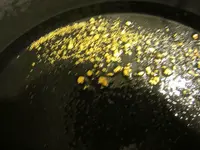You've been given some great advice already. Plus, it really helps if you research carefully, and if you've already done that, and the stream you're working is supposed to produce nice gold (what size are you looking for?), then re-read the above replies.
Now, having said all of that, you need to learn to look for traps for gold. Yes, you can read about the regular places (on the downstream side of a log, or rock obstruction, or boulder) that trap gold, and they do; however, if you're in a stream that's been worked hard, you're going to have to do a bit better than that.
One of the best places to find, if you know how to look for it, is a suction eddy. Now, a suction eddy would have formed when the river was running high, and it may be off to the side of a big batch of boulders, or a bedrock outcrop, or where a smaller stream intersects the larger stream, but the telltale signs will be a gouge in the bank or brush roots exposed in the bank, or a nest of soccer ball or watermelon-sized rocks tossed up on the bank or tossed on a sheet of parallel bedrock. (In a suction eddy, the river cuts back on itself [think of a whirlpool on the side of a stream] and in doing so, it pulls out heavier materials that would normally whistle on by: logs, nails, iron spikes, fishing weights, chunks of magnetite and hematite, galena, and of course, sassy chunks of gold!)
If you find an area like that, clean it right down to bedrock and if there are cracks and crevices in the bedrock, clean them all out. Most beginners fail to realize how heavy gold is and how far down it will work itself if given the opportunity. Plus, the nice thing about a suction eddy is that they renew themselves every season, or they are created brand-new in a completely virgin spot! And, always, always think of specific gravity while you ponder this, for if the stream disgorged rocks the size of watermelons and soccer balls into the suction eddy, it would also spit the gold in there as well.
I've found enough nuggets and coarse gold (as well as flake and fine gold) this way to never, ever overlook a suction eddy, especially in the springtime before anyone else has had the chance to check one out. Oh, and by the way, the gold may be just under the water as well, usually in shallow water (atop clay or bedrock) along the edge of the stream where the water was once maybe three feet higher when the river was in flood stage.
As well, don't be afraid to crack bedrock when you find nesting boulders resting on it. Moreover, I dredge for gold and I've watched gold skitter around a boulder and then disappear into a crack lickety-split! It happens super-fast, so respect that when you find a gold trap and investigate any underlying bedrock very carefully. Don't make the rookie mistake of only cleaning the surface of the bedrock--I repeat, don't just clean the surface, ever.
I've taken enough Rookies out now that if I want them to get some nice gold in their vial, I always take them to a spot with friable, or with fractured, bedrock that underlies a suction eddy, or a nest of boulders. Here's a rhyme to help you remember about suction eddies and obstructions on a river or stream: if the gold comes to a stop, it will drop. Remember--if it comes to a stop--it will drop. And, not only will it drop, but the bigger rocks dancing around on the bedrock in that jostling suction eddy will pound the bedrock ceaselessly, opening cracks that will let the gold drop even deeper, and hydraulic pressure will also force the gold down into the cracks because gold is almost twenty times as heavy as the water and almost ten times as heavy as the other, accompanying stream materials (rocks, oxidizing metals etc.).
All the best,
Lanny





